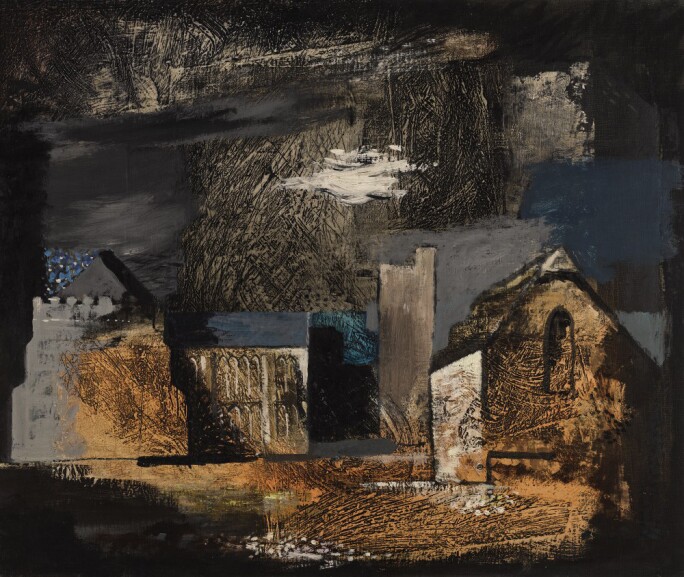
"I love the vibrant colour of Ivon Hitchens’ landscapes,” says Stella Tennant, co-creative director of Holland & Holland, the uniquely English clothesmaker who has been fitting out the aristocracy since 1835. “I want to wear those colours.”
Of course, Tennant started her career as a model and so the idea of colours springing to life and becoming wearable seems more natural than it might otherwise. She has a particular understanding of what works and what doesn’t, but, more than that, she has a very particular take on the British landscape, which can be seen in her work with Isabella Cawdor for Holland & Holland. Together they produce two collections a year that Cawdor describes as being inspired by “our own British backgrounds and our own understanding of British country life”. Tennant was once famously photographed in another iconic British style – punk – by Steven Meisel, while Cawdor was previously an editor at Vogue. It is this perspective that they have also brought to an exhibition of artworks selected from the Modern and Post-War British Art auction on 19 and 20 November in London.
Stella Tennant on Her Natural Affinity With Modern British Art
Together, Tennant and Cawdor helm one of the world’s most luxurious and unique fashion houses. Renowned for its outerwear, the company also produces everything from accessories to cashmere. At the root of what they do is a version of Britain that feels increasingly elusive. Tennant points out that they “work with various mills in Scotland and Cumbria to develop our own tweeds for each collection”. This is a level of detail that is not normally attended to.
Explore Works Featured in the Exhibition

Tennant and Cawdor talk passionately about art and the British landscape. “There were so many great painters in 20th-century British art who were inspired by British landscape,” says Cawdor. She goes on to name Paul Nash, Stanley Spencer, Graham Sutherland and Edward Burra as some of her favourites. “What attracts me to their work is their vision of Britain,” she says. She even finds specific colours can be inspirational – such as the “wonderful lilacs” in Winifred Nicholson’s paintings from her trips to the west coast of Scotland.
The pair have been looking at British art a lot recently. “Stella and I looked closely at the St Ives artists while working on spring/summer 2020. Their use of colour was truly inspirational to this collection,” she says. Patrick Heron, Ben Nicholson and Barbara Hepworth stood out in terms of the influence they wielded. The design duo is constantly relating the art and landscapes around them to their work. As Tennant explains, “estate tweeds directly refer to the colours specific to their location”. “You can see how Hepworth’s works are inspired by the elements around her,” she says. “There’s a parallel with this engagement with the natural environment. I love how Hepworth uses a contrast of texture, from very rough to a perfectly smooth curve, that’s inviting you to touch. The clothes we make are designed to work in the landscape, both visually and practically.”

This kind of attention affords an intimacy both to Tennant and Cawdor’s work and the way they look at art – which is apparent in their curation of the exhibition. “It has been very exciting seeing the various consignments come in,” says Tennant. “There’s so much variety. I like to see smaller sketches or collages that give insight into the artist’s thinking. I’m always fascinated by earlier works that hint towards how the artist will develop their individual style.”
"Piper gives a sense of full immersion in the atmosphere of a place."
Specific examples ring out for Tennant. “You can see how the reliefs by Ben Nicholson relate back to early drawings from the 1930s. Even the early landscape drawings by Bridget Riley echo the pattern, rhythm and colour of her mature work. As their careers progress, the works become pared down to the essentials.”

This quality is also apparent in works such as the John Piper painting that the two have selected. Tennant notes how Piper “gives a sense of full immersion in the atmosphere of a place” in his work.
Cawdor, meanwhile, relishes another sort of atmosphere, with her love for the London school of figurative painters. While the more familiar names are there – Auerbach, Bacon and Freud – Cawdor picks out Michael Andrews as an artist she admires hugely. “The artfulness in his technique is fascinating,” she says. There is something reassuringly connoisseurial in observations such as this. It makes sense that two designers who are dealing with a fabric that is as textured and can be read as closely as tweed – the very colours of which are specific to the landscape from which it is woven – should look at this period of art with such detail.

But as with all the greatest designers, there is also an overarching vision at work. In a field as diverse as Modern British Art, they have focused on the underlying abstractions of this period. As Tennant says, “With 20th-century British art you have the emergence of abstraction. There’s a huge range of experimentation during this period. Artists such as Howard Hodgkin explore vivid colours and bold composition with expressive brushstrokes, whereas the Op art of Bridget Riley is almost scientific in its rigorous and exact execution. The abstract sculptures of Henry Moore seem to grow out of the landscape.” It’s no surprise to see the co-directors drawn to the land. As Cawdor puts it when describing her own taste: “I am a lover of beautiful landscapes that can transport me away from routine life – places that inspire and allow me to dream.” •
































